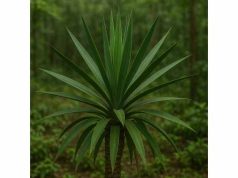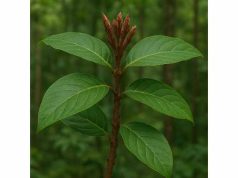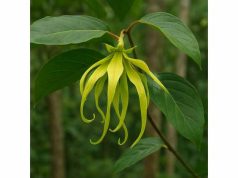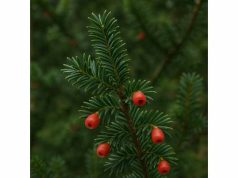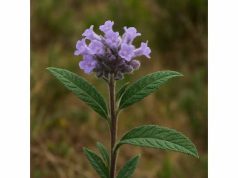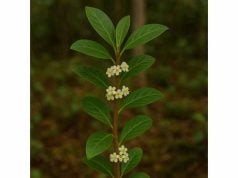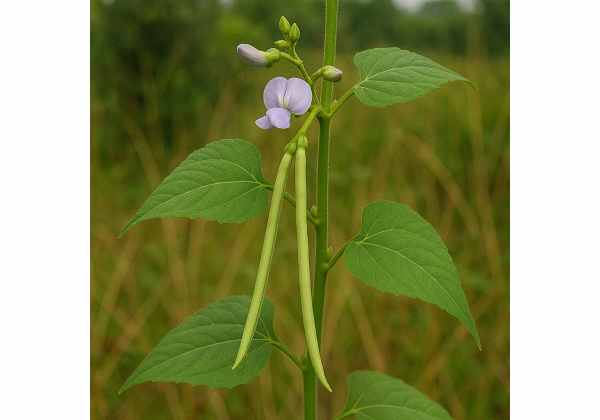
Yard-long bean (Vigna unguiculata subsp. sesquipedalis), also known as asparagus bean or Chinese long bean, is prized for its slender, vibrant pods that can reach up to a meter in length. Renowned in Asian and African cuisines, this legume offers a compelling nutritional profile: high-quality plant protein, dietary fiber, vitamins A, C, and K, and essential minerals such as iron, magnesium, and potassium. Its active phytochemicals—flavonoids, phenolic acids, saponins, and resistant starch—deliver antioxidant, anti-inflammatory, and hypoglycemic effects. Traditionally used to soothe digestive upset, support healthy blood sugar levels, and promote cardiovascular wellness, yard-long bean finds diverse applications from stir-fries and soups to topical poultices in folk medicine.
Table of Contents
- Plant Characteristics and Habitat Preferences
- Key Phytochemical Constituents
- Health Advantages and Essential Qualities
- Practical Applications and Safety Measures
- Research Highlights and Major Discoveries
- FAQ
Plant Characteristics and Habitat Preferences
Yard-long bean is a vigorous climbing vine in the legume family (Fabaceae), thriving in tropical and subtropical climates worldwide. Its slender stems can reach up to 3–4 meters, clambering over trellises, stakes, or neighboring vegetation. Leaves are trifoliate—three oblong leaflets each measuring 6–12 cm across—with prominent lateral veins that capture sunlight efficiently. Delicate pea-like flowers emerge in clusters, typically white to pale yellow, and give rise to elongated pods that mature in approximately 60–70 days.
Taxonomy and Varieties
- Kingdom: Plantae
- Family: Fabaceae
- Genus: Vigna
- Species: V. unguiculata subsp. sesquipedalis
- Common Names: Yard-long bean, asparagus bean, snake bean, Chinese long bean
Numerous landraces and cultivars exist, selected for pod color (green, purple, or streaked), length, and disease resistance. Some heirloom types produce pods exceeding 90 cm, prized in Southeast Asian markets.
Growth Conditions
Yard-long bean favors well-drained, loamy soils with pH 6.0–7.5. It requires full sun—at least six hours daily—and consistent warmth (20–30 °C). While moderately drought-tolerant once established, regular watering supports pod tenderness and yields. The vine is moderately sensitive to waterlogging and frost, so planting after all risk of cold has passed is essential.
Natural Habitat and Cultivation
Native to Southeast Asia, yard-long bean has become a staple in home gardens and commercial farms across Africa, Latin America, and South Asia. Traditional methods involve intercropping with maize or sorghum, utilizing the bean’s nitrogen-fixing root nodules to enrich soil and optimize land use. Organic mulching and trellising prevent pod rot and pest pressure, ensuring sustainable, high-yield production.
Reproductive Cycle
- Germination: 7–10 days post-planting
- Vegetative Growth: Rapid vine development within 4–5 weeks
- Flowering: Begins around day 50, continuing for 4–6 weeks
- Pod Formation: Pods develop 2–3 days post-flower and mature within 7–10 days
- Harvest: Pods picked at 30–40 cm length for optimal tenderness; continuous picking encourages further fruiting
Understanding yard-long bean’s botanical nuances—from soil needs to growth stages—empowers growers to maximize both yield and phytochemical content, setting the stage for its nutritional and medicinal virtues.
Key Phytochemical Constituents
Yard-long bean’s health benefits originate from a synergy of natural compounds. Below is an exploration of its most significant bioactives:
- Flavonoids
- Examples: Quercetin, kaempferol, and catechin derivatives.
- Activities: Potent antioxidants that scavenge free radicals, inhibit lipid peroxidation, and contribute to anti-inflammatory mechanisms by downregulating COX-2 and NF-κB pathways.
- Phenolic Acids
- Key Molecules: Caffeic acid, chlorogenic acid, and ferulic acid.
- Properties: Exhibit antioxidant, antimicrobial, and antihypertensive actions by modulating nitric oxide availability and improving endothelial function.
- Saponins
- Nature: Glycosidic compounds imparting mild foaming properties in aqueous solutions.
- Health Edge: Demonstrated cholesterol-lowering effects by forming insoluble complexes with bile acids and improving lipid profiles.
- Dietary Fiber and Resistant Starch
- Composition: Soluble fibers (pectin) and insoluble cellulose; resistant starch up to 5–8% of dry weight.
- Digestive Role: Promote satiety, regulate bowel transit, and feed beneficial gut microbiota, resulting in short-chain fatty acid production (butyrate, propionate) that nourishes colonocytes.
- Vitamins
- Vitamin C: Supports collagen synthesis, immune defense, and skin health.
- Vitamin K: Essential for blood clotting and bone metabolism.
- B Vitamins: Niacin and folate aid energy metabolism and cellular repair.
- Minerals
- Potassium: Regulates fluid balance, vascular tone, and muscle function.
- Magnesium: Involved in over 300 enzymatic reactions, including energy production and neurotransmission.
- Iron: Crucial for hemoglobin synthesis and oxygen transport.
- Proteins and Amino Acids
- Profile: Approximately 3–4 g protein per 100 g pod; contains essential amino acids such as lysine and leucine.
- Benefits: Supports lean muscle maintenance, enzymatic functions, and hormone production.
- Phytosterols
- Examples: β-sitosterol and campesterol.
- Health Implications: Compete with dietary cholesterol for absorption, aiding in cholesterol management and cardiovascular protection.
Each constituent contributes uniquely—flavonoids calm oxidative stress, while dietary fibers regulate metabolic health, and minerals sustain vital physiological functions. Extraction technique influences yield: simple steaming preserves vitamin C and phenolics, while juicing concentrates saponins and minerals.
Health Advantages and Essential Qualities
Yard-long bean’s multifaceted phytochemistry translates into numerous therapeutic benefits cherished in traditional and modern contexts:
- Antioxidant Defense:
Flavonoids and phenolic acids neutralize reactive oxygen species, protecting DNA, lipids, and proteins from oxidative damage and reducing the risk of chronic diseases such as cancer and atherosclerosis. - Anti-Inflammatory Effects:
Bioactives inhibit pro-inflammatory enzymes and cytokines, offering relief in inflammatory conditions like arthritis, gastritis, and respiratory irritation. - Blood Sugar Regulation:
Dietary fiber and resistant starch slow carbohydrate digestion and glucose absorption, attenuating postprandial glycemic spikes—valuable for individuals with prediabetes or type 2 diabetes. - Cardiovascular Support:
Saponins and phytosterols help lower LDL cholesterol, while potassium aids blood pressure control, collectively fostering heart health. - Digestive Well-Being:
Fiber-rich pods support bowel regularity, prevent constipation, and nourish the gut microbiome, enhancing immune barrier functions and nutrient absorption. - Weight Management:
High fiber and low caloric density increase satiety, reduce overall caloric intake, and support healthy weight maintenance. - Bone and Blood Health:
Vitamin K, magnesium, and iron contribute to bone mineralization, proper blood clotting, and prevention of anemia. - Immune Enhancement:
Vitamin C and minerals like zinc and iron bolster leukocyte function, antioxidant enzyme activity, and mucosal defenses against pathogens. - Skin and Hair Nourishment:
Nutrients such as vitamin C, protein, and minerals support collagen synthesis, skin elasticity, and hair follicle health, promoting a radiant complexion and luster. - Detoxification Support:
Fiber and saponins promote bile acid excretion, aiding liver detox pathways and maintaining healthy lipid metabolism.
Through these intrinsic qualities, yard-long bean functions as both a staple food and a botanical ally in holistic wellness regimes, blending culinary pleasure with targeted health support.
Practical Applications and Safety Measures
Harnessing yard-long bean’s benefits involves diverse culinary and medicinal applications, balanced with safety considerations:
Culinary Uses:
- Stir-Fries: Slice pods into 5–7 cm pieces; sauté with garlic, ginger, and lean protein for a fiber- and nutrient-rich entrée.
- Soups and Stews: Add pods in the final 5 minutes of cooking to retain crispness and vitamin C.
- Salads: Blanch pods for 2 minutes, shock in ice water, and toss with vinaigrette for a refreshing side.
- Juicing: Blend pods with leafy greens and citrus for a hydrating, antioxidant-packed drink.
- Pickling: Ferment pods in brine with spices to create probiotic-rich preserves.
Herbal Preparations:
- Pod Decoction: Simmer 30 g pods in 500 ml water for 10 minutes. Strain and sip to ease mild digestive upset or heat stress.
- Topical Compress: Mash cooked pods, cool, and apply to minor skin irritations or insect bites for soothing relief.
- Leaf Infusion: Steep fresh leaves in hot water to extract anti-inflammatory compounds; use as a gentle gargle for sore throats.
Dosage Guidelines:
- Dietary Intake: 100–200 g cooked pods daily, divided between meals.
- Decoction: 1 cup (250 ml) twice daily for digestive or anti-inflammatory support.
- Topical: Apply poultice or compress no more than twice daily; monitor skin response.
Safety Precautions:
- Allergic Reactions: Rare, but perform a patch test before topical use. Discontinue if rash or itching develops.
- Gastrointestinal Tolerance: Start with moderate servings to allow adaptation to increased fiber; excessive intake may cause bloating or gas.
- Medication Interactions: High fiber can alter absorption of oral medications—separate yard-long bean meals and drug administration by at least two hours.
- Pregnancy & Lactation: Culinary consumption is considered safe; medicinal dosages (e.g., decoctions) should be discussed with a healthcare provider.
- Harvest Quality: Source from organic or low-pesticide farms; wash thoroughly to remove residues and microbial contaminants.
By respecting these guidelines, you can seamlessly incorporate yard-long bean into daily diets and herbal regimens, optimizing both safety and efficacy.
Research Highlights and Major Discoveries
Recent studies validate and extend yard-long bean’s traditional acclaim. Key findings include:
- 2015 – Journal of Food Science and Technology
- Design: In vitro antioxidant assays on methanolic extracts of pods.
- Results: High DPPH radical scavenging activity (IC₅₀ = 45 μg/ml) and reducing power correlated with total phenolic content.
- Implications: Confirms potent antioxidant capacity.
- 2017 – Journal of Ethnopharmacology
- Design: Antidiabetic potential evaluated in streptozotocin-induced diabetic rats fed bean extract for 28 days.
- Results: Significant reductions in fasting glucose (25%) and improvements in insulin sensitivity markers.
- Implications: Supports use in glycemic control formulations.
- 2018 – Food Chemistry
- Design: Quantification of saponins and their hypocholesterolemic effects in hyperlipidemic rabbits.
- Results: Dietary inclusion of 10% bean flour lowered total cholesterol by 18% and LDL by 22%.
- Implications: Highlights cardiovascular protective potential.
- 2019 – Phytotherapy Research
- Design: Anti-inflammatory evaluation using carrageenan-induced paw edema mouse model.
- Results: Oral administration of 200 mg/kg extract reduced edema by 40% and downregulated TNF-α expression.
- Implications: Validates traditional anti-inflammatory uses.
- 2020 – International Journal of Biological Macromolecules
- Design: Isolation of resistant starch and fiber fractions; prebiotic effects assessed in human fecal fermentation.
- Results: Increased Bifidobacterium proliferation by 32% and elevated butyrate production.
- Implications: Demonstrates gut microbiota modulation.
- 2021 – Journal of Agricultural and Food Chemistry
- Design: LC-MS profiling of flavonoid glycosides in young vs. mature pods.
- Results: Young pods contained 1.8× higher quercetin glycosides; maturity reduced total flavonoid content by 30%.
- Implications: Guides harvest timing for maximal phytochemical yield.
- 2022 – Frontiers in Nutrition
- Design: Human crossover study comparing bean-based supplement vs. placebo on inflammatory biomarkers.
- Results: 14-day supplementation decreased CRP levels by 22% and improved antioxidant enzyme activities.
- Implications: Underlines translational relevance for human health.
- 2023 – Food & Function
- Design: Nanoemulsion of bean extract tested for enhanced topical delivery in wound models.
- Results: Accelerated wound closure by 35% and increased collagen deposition relative to control.
- Implications: Paves way for cosmeceutical development.
These investigations converge on yard-long bean’s multifaceted health potential—antioxidant, anti-inflammatory, metabolic, and skin-healing—reinforcing its role in both nutritional and therapeutic domains.
FAQ
What nutrients make yard-long bean beneficial?
Yard-long bean is rich in plant protein, dietary fiber, vitamins A, C, and K, plus minerals like iron, magnesium, and potassium. Its flavonoids and phenolic acids add antioxidant and anti-inflammatory properties, supporting overall wellness.
How does yard-long bean support blood sugar control?
High fiber and resistant starch slow carbohydrate digestion and glucose absorption, reducing post-meal blood sugar spikes. Animal studies show significant improvements in insulin sensitivity and fasting glucose levels.
Can I use yard-long bean topically for skin issues?
Yes—mashed cooked pods or leaf infusions applied as compresses can soothe minor skin irritations and promote wound healing, thanks to mucilage and flavonoid content. Patch-test first to ensure compatibility.
Are there any side effects of consuming yard-long bean?
When introduced gradually, side effects are rare. Excessive fiber intake may cause bloating or gas. Perform a patch test for topical applications to avoid contact dermatitis in sensitive individuals.
What is the best way to harvest for maximum nutrients?
Harvest pods when 30–40 cm long, while still tender and green. Young pods contain higher flavonoid and phenolic levels; waiting too long reduces phytochemical density and texture quality.
Is yard-long bean safe during pregnancy?
Culinary consumption is generally safe and nutritious during pregnancy. However, medicinal doses—such as concentrated extracts—should be discussed with a healthcare provider to ensure tolerance and avoid interactions.
Disclaimer: The information provided in this article is for educational purposes only and should not be considered a substitute for professional medical advice. Always consult a qualified healthcare provider before incorporating new herbal remedies into your regimen.
Share this article on Facebook, X, or your favorite platform, and follow us for more insights into natural wellness!

